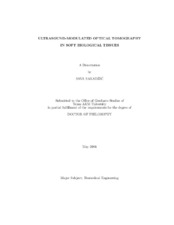| dc.description.abstract | Optical imaging of soft biological tissues is highly desirable since it is nonionizing
and provides sensitive contrast information which enables detection of physiological
functions and abnormalities, including potentially early cancer detection. However,
due to the diffusion of light, it is dificult to achieve simultaneously both good spatial
resolution and good imaging depth with the pure optical imaging modalities.
This work focuses on the ultrasound-modulated optical tomography - a hybrid
technique which combines advantages of ultrasonic resolution and optical contrast.
In this technique, focused ultrasound and optical radiation of high temporal co-herence are simultaneously applied to soft biological tissue, and the intensity of the
ultrasound-modulated light is measured. This provides information about the optical
properties of the tissue, spatially localized at the interaction region of the ultrasonic
and electromagnetic waves.
In experimental part of this work we present a novel implementation of high-resolution ultrasound-modulated optical tomography that, based on optical contrast,
can image several millimeters deep into soft biological tissues. A long-cavity confocal
Fabry-Perot interferometer was used to detect the ultrasound-modulated coherent
light that traversed the scattering biological tissue. Using 15-MHz ultrasound, we
imaged with high contrast light absorbing structures placed 3 mm below the surface
of chicken breast tissue. The resolution along the axial and the lateral directions with respect to the ultrasound propagation direction was better than 70 and 120¹m, respectively. This technology is complementary to other imaging technologies,
such as confocal microscopy and optical-coherence tomography, and has potential for
broad biomedical applications.
In the theoretical part we present various methods to model interaction be-tween the ultrasonic and electromagnetic waves in optically scattering media. We first extend the existing theoretical model based on the diffusing-wave spectroscopy
approach to account for anisotropic optical scattering, Brownian motion, pulsed ul-trasound, and strong correlations between the ultrasound-induced optical phase in-crements. Based on the Bethe-Salpeter equation, we further develop a more general
correlation transfer equation, and subsequently a correlation diffusion equation, for
ultrasound-modulated multiply scattered light. We expect these equations to be
applicable to a wide spectrum of conditions in the ultrasound-modulated optical tomography of soft biological tissues. | en |


